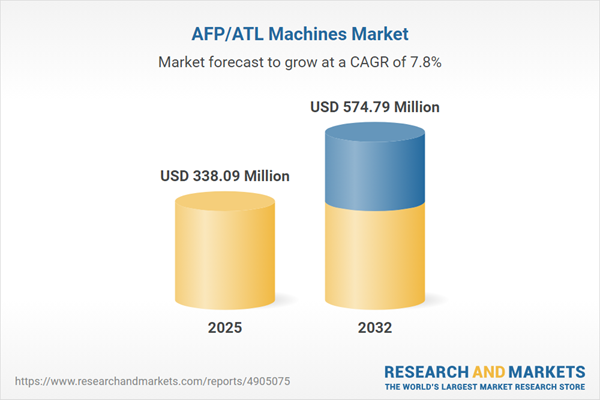Speak directly to the analyst to clarify any post sales queries you may have.
Advanced fiber placement and automated tape laying machines are reshaping high-value manufacturing across aerospace, automotive, energy, and marine sectors. As manufacturers face pressure to innovate, streamline production, and future-proof supply chains, these intelligent automation systems deliver precision, agility, and adaptability within evolving global markets.
Market Snapshot: AFP/ATL Machines Market Size and Growth
The AFP/ATL Machines Market grew from USD 314.24 million in 2024 to USD 338.09 million in 2025 and is projected to sustain a 7.84% CAGR, reaching USD 574.79 million by 2032. This growth reflects industry-wide investments aimed at improving performance, reducing weight, and achieving tighter manufacturing tolerances in composite part fabrication.
Scope & Segmentation: Strategic View of the AFP and ATL Machines Market
This report investigates how automation, material innovation, and changing regulatory landscapes influence the adoption and deployment of advanced fiber placement and automated tape laying technologies. It provides a comprehensive segmentation to guide strategic decisions:
- Product Types: Contour tape laying machines, flat tape laying machines, horizontal gantry systems, robotic arms, vertical gantry systems.
- Material Types: Carbon fibre, glass fibre.
- Automation Levels: Fully automated, semi-automated systems.
- End-Use Industries: Aerospace and defense (commercial aviation, military applications), automotive (body and structural components), energy (nuclear, wind energy), and marine (deck and hull structures).
- Regional Analysis: Americas (United States, Canada, Mexico, Brazil, Argentina, Chile, Colombia, Peru), Europe/Middle East/Africa (United Kingdom, Germany, France, Russia, Italy, Spain, Netherlands, Sweden, Poland, Switzerland, UAE, Saudi Arabia, Qatar, Turkey, Israel, South Africa, Nigeria, Egypt, Kenya), and Asia-Pacific (China, India, Japan, Australia, South Korea, Indonesia, Thailand, Malaysia, Singapore, Taiwan).
- Key Company Profiles: Accudyne System, Addcomposites Oy, AFPT GmbH, Boikon BV, Broetje-Automation, Camozzi Group, Compositence GmbH, Conbility, Coriolis Group, Credit Carbon Axis, Electroimpact, Excelitas Noblelight, FIVES Group, General Electric, Lockheed Martin, M.Torres Diseños Industriales, Mikrosam DOO, MTorres, North Thin Ply Technology, Trelleborg AB, Tsudakoma Kogyo.
Key Takeaways: Strategic Insights for Decision-Makers
- The integration of robotics and digital controls in AFP and ATL systems is enabling manufacturers to reduce manual intervention, improve repeatability, and achieve greater quality consistency, especially in high-precision segments.
- Artificial intelligence and closed-loop feedback empower real-time defect detection and process adaptation, minimizing production waste and downtime.
- Sustainability is a growing priority as producers seek both energy-efficient drive systems and recyclable thermoplastic tapes, aligning machine capabilities with end-of-life disassembly and environmental targets.
- Deployment of digital twins and virtual commissioning shortens development cycles and streamlines production ramp-up, increasing competitiveness for early adopters.
- End-use sector adoption is diversifying, with aerospace, automotive, wind energy, and marine industries leveraging tailored configurations to address performance, safety, and cost objectives.
Tariff Impact: Navigating Cost and Supply Chain Shifts
The 2025 introduction of new tariffs on imported AFP and ATL components has led manufacturers to review sourcing strategies, negotiate local partnerships, and invest in regional hubs. These measures have driven a focus on order consolidation, predictive maintenance adoption, and nearshoring to reduce cost exposure and support operational continuity. Supply chain agility is now pivotal to minimize risk amid shifting policy environments.
Methodology & Data Sources
This report leverages extensive secondary research, structured executive interviews, and performance benchmarking. Market segmentation has been validated through triangulation of technical documentation, public data, and direct R&D engagement, ensuring every insight is both reliable and actionable.
Why This Report Matters: Decision-Relevant Intelligence
- Equips leaders with a clear, segmented view of the AFP/ATL market, highlighting actionable opportunities and supplier dynamics across diverse geographies and end-user industries.
- Helps align investment strategies by clarifying the technology landscape, emerging performance standards, and global supply chain realities.
- Supports risk management and value capture through in-depth analysis of regulatory change, tariff impacts, and sustainability trends.
Conclusion: Strategic Alignment for Sustainable Growth
As advanced fiber placement and automated tape laying technologies redefine manufacturing benchmarks, a proactive and informed approach ensures competitive advantage in a dynamic market. Strategic partnerships, digital adoption, and supply chain flexibility remain core to unlocking long-term value.
Additional Product Information:
- Purchase of this report includes 1 year online access with quarterly updates.
- This report can be updated on request. Please contact our Customer Experience team using the Ask a Question widget on our website.
Table of Contents
3. Executive Summary
4. Market Overview
7. Cumulative Impact of Artificial Intelligence 2025
Companies Mentioned
The companies profiled in this AFP/ATL Machines market report include:- Accudyne System, Inc.
- Addcomposites Oy
- AFPT GmbH
- Boikon BV
- Broetje-Automation GmbH by Shanghai Electric Group Corp
- Camozzi Group S.p.A.
- Compositence GmbH
- Conbility GmbH
- Coriolis Group Sas
- Credit Carbon Axis SAS
- Electroimpact, Inc.
- Excelitas Noblelight GmbH
- FIVES Group
- General Electric Company
- Lockheed Martin Corporation
- M.Torres Diseños Industriales SAU
- Mikrosam DOO
- MTorres Diseños Industriales S.A.U.
- North Thin Ply Technology Sàrl
- Trelleborg AB
- Tsudakoma Kogyo Co., Ltd.
Table Information
| Report Attribute | Details |
|---|---|
| No. of Pages | 197 |
| Published | November 2025 |
| Forecast Period | 2025 - 2032 |
| Estimated Market Value ( USD | $ 338.09 Million |
| Forecasted Market Value ( USD | $ 574.79 Million |
| Compound Annual Growth Rate | 7.8% |
| Regions Covered | Global |
| No. of Companies Mentioned | 22 |









